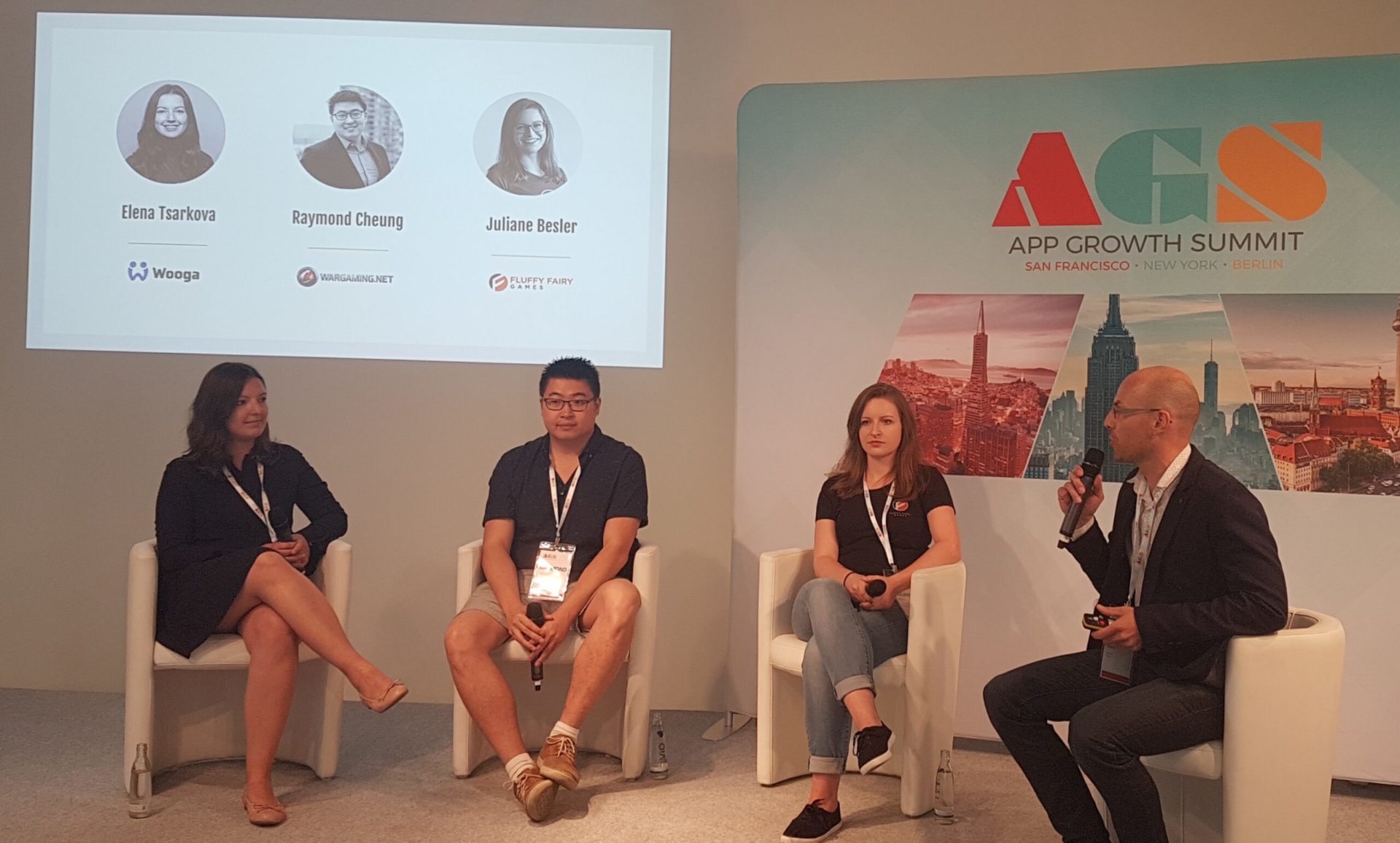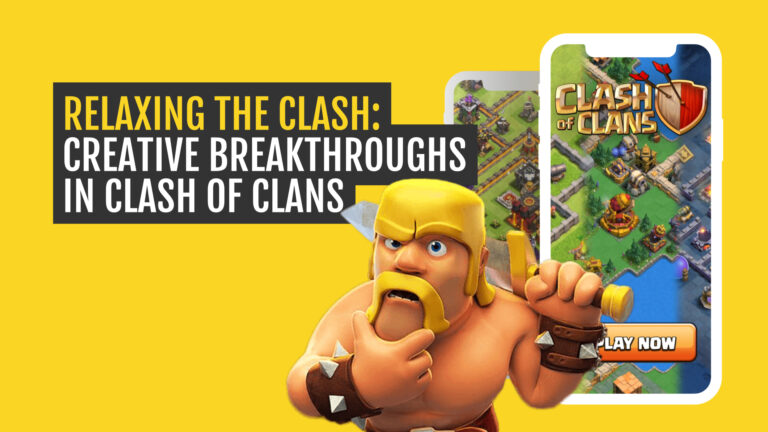User Acquisition managers are looking for great ad creatives like never before. An ad that achieves a high click-through rate, posts strong install numbers and manages to retain users is the best way to fight increasing acquisition costs.
I reached out to three great mobile marketers, who produce tons of creatives every week, to learn about how they regularly produce effective ads that drive conversions. We gathered at the App Growth Summit in Berlin for a panel discussion and agreed to share the outcomes from the session in a blog post.
In this article, Elena Tsarkova from Wooga, Raymond Cheung from Wargaming, and Juliane Besler from Fluffy Fairy Games will walk you through:
– how to structure your team
– the pros and cons of outsourcing
– what the creative process looks like
– how to test creatives and provide feedback to designers
– whether gameplay videos perform better than cinematics
– which trends to follow in 2018.

Team structure
Typically, it’s the UA manager who defines what, and how many, adverts are needed. In bigger teams, there’s normally a marketing producer that either manages an in-house team or a network of external agencies and freelancers.
Smaller companies often rely on a more direct approach. At Fluffy Fairy Games the internal team consists of three UA managers, two designers and a marketing manager.
Music video for Idle Miner Tycoon by Fluffy Fairy Games still shows a lot of gameplay
They organise their production through a Monday briefing and a Friday evaluation stand-up. The weekly cycle matches the frequency of game updates. The team uses Google Sheets for documentation of what kind of creatives ideas were talked about and which has high and low priority. The document also summarize what needs to be done the current week or can be postponed after it’s discussed in face to face meeting. Such a lean team is capable of producing a couple of new app icons and a few screenshots every week, with a new video every 2-4 days. Other creative formats like gifs or static images are less of a priority, with playable ads usually produced by ad networks.
“Always test new creative ideas and don’t be afraid to be crazy.”
– Elena Tsarkova, UA manager at Wooga
While Fluffy Fairy Games manages two titles, Wooga currently supports four at the same time. The volume of work is increased, with the team producing around 10-20 ads every week, with video making up 85%, static ads 10%, and playable ads 5%. At this scale, a marketing producer and creative director are necessary to support the UA team. The producer is responsible for the efficient production of all ads and their timing. They manage the technical aspects of development, with the creative director overseeing the quality and its fit with the brand.
A very simple but highly converting video ad for Wooga’s Bubble Island 2
In-house production vs outsourcing
Large publishers like Wargaming or Gameloft usually have their own in-house creative teams. Paris-based Gameloft, which runs its user acquisition activities from offices in Budapest, Sofia, Paris, London and many more, has its main creative hub in Barcelona. At Wargaming, the Marketing Creative Studio (MCS) in the Minsk office consists of 150 artists who are managed by several producers, each focusing on a selected game from their large portfolio of desktop, console and mobile titles. Wargaming can effectively leverage the assets they create for desktop titles, quickly reusing them for mobile titles like World of Warships Blitz. The deep understanding of players, the game itself and the brand that all exist in-house are the main pros for this approach.
On the other hand, Berlin-based casual games publisher Wooga relies completely on outsourcing their ad creatives. Working with five agencies and freelancers, ads for hit games Bubble Island 2, June’s Journey or their newest title Tropicats don’t suffer from a lack of new ideas or diversity in their execution style. Outsourcing has also a big advantage once the publisher (soft) launches a number of games in a short period of time. It enables them to scale up to support UA efforts.
“I try to have about 4-10 creatives available at a single time. Once their performance fades, I always try to get new creatives into the pool.”
– Antti Paikalla, UA manager at Small Giant Games
The creative pipeline
The creative brief is an essential part of a successful production process. In small marketing teams, like those at Fluffy Fairy Games, a verbal briefing is usually enough. In my experience, writing down key requirements always helps to clarify thoughts and to avoid misunderstandings later.

When developing a brief, Elena from Wooga includes not only the technical requirements but also her preferred creative direction, including theme, tone and best practice insights learned from previous campaigns. Each new brief starts with an in-depth analysis of previous campaigns, transforming complex performance data into language that’s clear and simple. Elena prefers to iterate the winning ad by experimenting with CTA, color and ad copy. She kills the worst performers and suggests new concept ideas for each creative cycle. Such creative meetings happen bi-weekly, with two rounds of feedback usually necessary to fine-tune the ad so that it’s ready to be published.

Wooga’s creative brief and one of the concepts visualized below

At Wargaming, it’s the Product Marketing Manager who controls the creative flow. The process starts by analysing the performance of previous campaigns, exploring why particular creatives worked well, and which variations should be tested next.
Raymond likes to reference the best performers and to provide concept direction based on the content of the new game, or seasonality. This information is conveyed to Vitaliy Kolomiyets, a producer based in Minsk, who organises the MCS team and translates the English brief into Russian. Concepts are presented in different forms – sometimes as a written storyline with reference images, sometimes as a storyboard with snapshots from other videos. The form usually depends on the concept itself. Vitalij also handles most of the ad tweaks and only consults with the Product Marketing Manager on major issues.
“Providing references – either from your own portfolio or competitors’ ads – helps to get everyone in the team on the same page when it comes to the expected look and feel of the ad.”
– Raymond Cheung, Product Marketing Manager at Wargaming
When it comes to long-term planning, Raymond has a detailed ad production roadmap for one month, which includes about 15 videos and one playable ad. Sitting alongside it is a budgeting plan for the quarter which outlines the expected workload. About 10% of the budget is allocated for testing new formats, placements or ad networks. This figure is standard across all of the companies we spoke to.

The concept presentation of the “Soviet Destroyers” ad and the final execution below.
The power of the storyboard
Coming from a traditional ad agency background at Leo Burnett, AppAgent’s Creative Director Richard Horin insists on a detailed brief and classic storyboard for every ad. He manages ad production for several publishers, including Pixonic, and has recently started to work with award-winning studio Small Giant Games. When working with any client, AppAgent produces an online version of the brief in Google Forms and presents hand-sketched keyframes with descriptions of the action and sound to our clients. This way, both the client and the motion designer fully understand the concept for the creative, and at the same time, the creative director isn’t limited by the existing assets.

“To tell the truth, we have skipped the storyboarding process a few times in the past hoping to speed up the production process. The opposite was true. It always went back as a boomerang, either with the client changing things on the go, or with more iterations with the motion designer,” comments Richard.
The ad for War Robots in the style of Quentin Tarantino strictly follows the storyboard above.
Gameplay vs Cinematic vs Live Action
There is a strong consensus among mobile marketers that showing the actual gameplay in video ads works the best. Obviously, players want to understand how the game plays, how it looks and to see if it matches their favorite titles. Yet the pure screen capture edited in iMovie sometimes isn’t enough to capture the distracted attention of a potential player in a newsfeed. A powerful video needs to catch the eye of players, and boost the Click Through Rate.
A gameplay wrapped in an eye-catching environmental background, that’s our recent ad for Geewa’s Smashing Four
“I see publishers often failing to explain what the game or app is about. Is it multiplayer? Is it about finding hidden objects? Is it a twist on a well-known game mechanic? Tell it and use any tactic to clearly communicate WHY people should invest time and make a download. The form is secondary,” explains Richard Horin.
During our discussion, both Juliane from Fluffy Fairy Games and Elena from Wooga agreed on the power of gameplay videos. Raymond threw in his two cents about cinematics (computer generated videos): “Videos with more cinematic content are addressing different audiences than those presenting mostly gameplay. By using them we can speak to a wider spectrum of players, including those who are not yet into war simulations and won’t respond to less attractive gameplay content.” This again demonstrates how important it is to look at user acquisition holistically and to break down the walls between marketing manager, UA manager and the creative team.
In some cases, even live action videos with actors make sense. Pokémon Go, for example, is a great example where real footage can showcase the gameplay. If you don’t have the time – or the budget – to do this, you can also leverage videos from your influencers and edit them into ads. They can look more like user generated content than an ad, which can definitely be a plus.
2018’s hot trend: Playable ads
The current hot trend is for playable ads. They are available as part of video ad networks like Unity Ads or Chartboost, but are extending their reach. Google now allows interactive HTML5 (rewarded) ad in UAC campaigns, and Facebook also runs a playable format in a closed beta. Given their interactivity, it’s no wonder Miniclip sees a three times higher click-through rate and 25 percent lower cost-per-install using them.
They’re successful because playable ads perfectly pre-qualify players at the top of the funnel. The great thing about playables is also the production time which is often shorter than for mid- to high-end video ads. Once the designer has all the required assets and a good concept, it takes about a week to produce the ad which makes this opportunity even more attractive.







